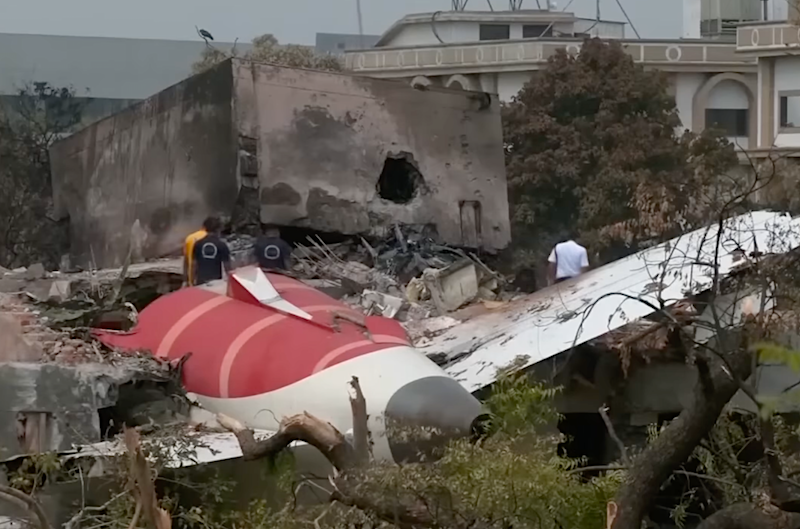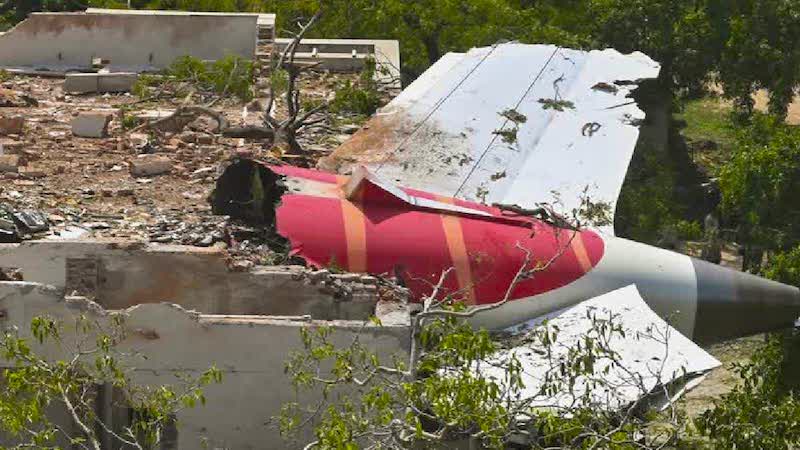 The crash killed 241 out of 242 on board the Boeing 787 Dreamliner and 19 others on ground.
The crash killed 241 out of 242 on board the Boeing 787 Dreamliner and 19 others on ground.
New Delhi: The preliminary investigation into the catastrophic Air India Flight 171 crash has revealed that both engine fuel-control switches mysteriously moved from the “run” to “cutoff” position just seconds after take-off, starving the Boeing 787-8 Dreamliner of fuel and causing the loss of 260 lives on June 12.
The Aircraft Accident Investigation Bureau (AAIB) report, released on July 12, provides the first official insight into what caused the aircraft to lose all engine power during the most critical phase of flight. The findings have sent shockwaves through the aviation industry and raised profound questions about aircraft safety systems.
Air India Flight 171 departed Ahmedabad’s Sardar Vallabhbhai Patel International Airport at 1.39pm on June 12, bound for London Gatwick Airport. The aircraft, a 12-year-old Boeing 787-8 Dreamliner registered as VT-ANB, was carrying 242 people including 230 passengers and 12 crew members.
The tragedy unfolded with devastating speed. At 8.08am and 39 seconds UTC, the aircraft lifted off normally, reaching its maximum recorded airspeed of 180 knots (333.36 kilometres per hour or 207.14 miles per hour) just three seconds later. Within moments, both Engine 1 and Engine 2 fuel cutoff switches transitioned from run to cutoff position, one after another with a gap of just one second.
Chilling cockpit exchange
Perhaps the most disturbing aspect of the preliminary findings is the cockpit voice recording that captured a brief but telling exchange between the pilots. One pilot was heard asking, “Why did you cut off?” to which the other responded, “I did not do so.” This conversation suggests that neither pilot was consciously aware of activating the fuel cutoff switches, deepening the mystery surrounding the disaster.
As India Sentinels had reported earlier, the flight crew consisted of Captain Sumeet Sabharwal, 56, a highly experienced pilot with 15,638 total flight hours including 8,600 hours on the Boeing 787, and First Officer Clive Kunder, 32, who had 3,403 hours of total experience with 1,128 hours on the B787. Tragically, Sabharwal was just days away from retirement, having told his 82-year-old father that he planned to quit flying to care for him full-time.
The 2018 warning that went unheeded
A critical element of the investigation centres on a 2018 Special Airworthiness Information Bulletin issued by the US Federal Aviation Administration. The bulletin, numbered SAIB No. NM-18-33 and dated December 17, 2018, warned about the “potential disengagement of the fuel-control switch locking feature” in Boeing aircraft, including the 787-8.
The advisory highlighted that some Boeing 737 aircraft had fuel-control switches installed with their locking mechanisms disengaged, which could lead to inadvertent movement during flight and potentially cause “an unintended consequence, such as an in-flight engine shutdown”.
Significantly, Air India did not perform the recommended inspections because the FAA bulletin was “advisory and not mandatory”. The fuel-control switch design, including the locking feature, was identical across various Boeing aircraft models, including part number 4TL837-3D fitted in the crashed aircraft.
Multiple safety mechanisms bypassed
Aviation experts have emphasized that fuel-control switches are designed with multiple safety mechanisms to prevent accidental activation. These switches are spring-loaded to remain in position and require deliberate action – pilots must first lift the switch before moving it from “run” to “cutoff”. The switches are also bracketed on either side to prevent accidental movement.
US aviation safety expert John Cox told Reuters that pilots cannot simply bump the switches by mistake: “You can’t bump them, and they move.” The switches control fuel flow to the engines and are typically only moved on the ground during engine start-up and shutdown, or in emergency situations requiring engine shutdown.
Expert opinions divided
The aviation community has offered varied perspectives on the crash findings. Captain Mohan Ranganathan, an internationally renowned safety expert and former Boeing aircraft trainer, while talking to NDTV, stated that the preliminary report proves the accident was a case of “deliberate human intervention”, emphasizing that “the fuel switch does not change automatically. It needs to be moved physically from one slot to another slot and can only be done as a deliberate action”.
However, highly experienced former Indian Air Force Sukhoi-30MKI pilot Group Captain Sivaraman Sajan had a different take. The veteran pilot pointed to the 2018 Special Airworthiness Information Bulletin issued by the US Federal Aviation Administration, as mentioned earlier, and suggested that “jumping to the conclusion that pilots of AI171 selected both fuel cut-off switches off” may be premature.
I see many people jumping to the conclusion that pilots of #AI171 selected both fuel cut off switches off. AAIB interim report states that fuel cutoff switches “transitioned” from RUN to CUTOFF position one after another within 1 sec. Point to be noted is ? pic.twitter.com/1RhwrJn7sI
— sajan (@sajaniaf) July 12, 2025
Other experts too urged caution against premature conclusions. Aviation safety expert Mark D Martin, CEO of Martin Consulting, raised concerns about potential Boeing 787 fuel system glitches, noting that no competent pilot would deliberately interact with fuel switches during the critical take-off phase. He highlighted a significant omission in the preliminary findings: the absence of cockpit camera footage, despite the Boeing 787 being equipped with cameras that would capture all pilot movements.
Former FAA safety engineer Mary Schiavo suggested that the crash might involve Thrust Control Malfunction Accommodation (TCMA) and Full Authority Digital Engine Control (FADEC) systems, based on previous incidents involving Boeing 787 aircraft. She referenced a 2019 All Nippon Airways flight where the TCMA malfunctioned, as concluded by the National Transportation Safety Board.
Industry pushback
The Airline Pilots’ Association of India has criticized the investigation’s direction, claiming it shows “a bias toward pilot error” and demanding a “fair, fact-based inquiry”. The association has called for pilot representatives to be included in the investigation process to ensure transparency.
The union’s concerns reflect broader industry unease about the preliminary findings. Aviation journalist Ajay Awtaney cautioned against premature conclusions, writing: “Remember, a preliminary report lays out the facts of the case, not the why of the case. The only thing conclusive is that the fuel to engines was cut.”
The civil aviation minister, Ram Mohan Naidu, has emphasized that the report is preliminary and urged against jumping to conclusions, stating he has “complete faith” in India’s pilots and crew.
Clean maintenance record
The investigation revealed that VT-ANB had a relatively clean maintenance record. The aircraft’s throttle control module was replaced in 2019 and 2023, though these replacements were unrelated to fuel-control switch issues. The right engine was installed in March 2025, while the left engine was installed in May 2025. No defects related to the fuel-control switches had been reported since 2023.
The Boeing 787-8 Dreamliner, first delivered to Air India in 2012, had accumulated approximately 58,000 flight hours across its operational life. The aircraft had undergone its last major maintenance check in April 2025, with no significant issues reported.
Ongoing investigation
The AAIB report emphasizes that “at this stage of investigation, there are no recommended actions to B787-8 and/or GE GEnx-1B engine operators and manufacturers”. This suggests that investigators have not yet identified any systemic issues with the aircraft type or engines that would warrant immediate safety measures.
The investigation continues with support from the US National Transportation Safety Board, Boeing, GE Aerospace, and other international stakeholders. The final report, expected within a year, will provide definitive answers about what caused both fuel-control switches to move to the cutoff position during the critical moments after take-off.
Boeing has stated it is cooperating fully with the investigation, while GE Aerospace, which manufactured the engines, has also pledged complete support to determine the cause of the tragedy.
Broader implications
The Air India crash has highlighted potential vulnerabilities in fuel-control systems and raised questions about the adequacy of non-mandatory safety advisories. The incident has prompted calls for the aviation industry to review the effectiveness of advisory bulletins versus mandatory airworthiness directives.
Aviation safety experts note that while preliminary reports provide crucial factual information, they do not establish causation. The ultimate determination of what caused the fuel switches to move will require extensive analysis of flight data, cockpit voice recordings, aircraft systems, and human factors.
The tragedy represents one of the deadliest aviation disasters in recent years and has profound implications for Boeing 787 operations worldwide. Airlines operating the Dreamliner are closely monitoring the investigation’s progress, though no immediate operational restrictions have been imposed on the aircraft type.
The loss of Flight AI171 serves as a stark reminder of the complex interplay between human factors, mechanical systems, and safety protocols in modern aviation. As the investigation continues, the aviation industry awaits answers that could reshape safety procedures and prevent similar tragedies in the future.
The final report will ultimately determine whether this catastrophe resulted from human error, mechanical failure, or a combination of factors that exposed previously unknown vulnerabilities in one of the world’s most advanced commercial aircraft.

